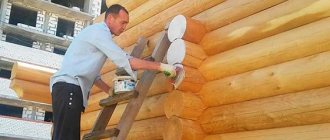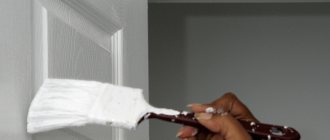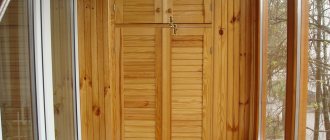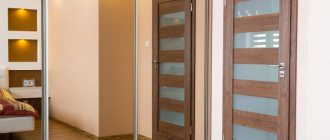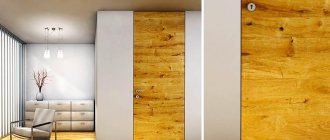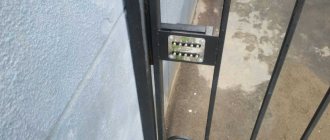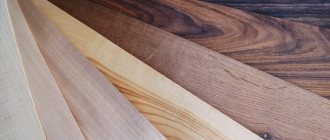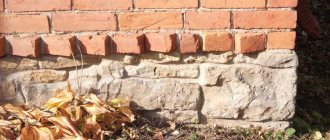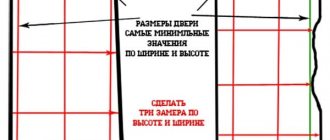It is difficult to find an apartment that does not have plastic doors installed on the balcony. They are comfortable, easy to clean, and protect well from the cold and noise coming from the street. In addition, such products are not too expensive. But in winter it often happens that cold air blows from a plastic door. There can be many reasons for such discomfort, but more often than not, a simple adjustment or replacement of the seal is enough to get rid of the problem. All this can be done with your own hands. Next, we’ll look at why it’s blowing from a plastic balcony door, and how to fix it.
Adjusting the plastic door
Any mechanism requires repair or adjustment of its operation from time to time, and fittings for opening and closing a plastic door - even the highest quality ones - are no exception.
A door installation company is not always ready to provide this service, and if it does this, you will have to wait several days for the specialists to arrive. It will take much less time to adjust the door yourself - it requires minimal skills that anyone can master.
Preventing drafts
Preventative measures against drafts must be applied immediately after installation. After installation, you must carefully check the work of the craftsmen, and if you find any defects, immediately inform the installer of the window systems.
The balcony door must be operated in compliance with the rules and promptly cleaned of dirt.
Simple problems can be resolved by setting up and adjusting the windows yourself. This helps get rid of drafts quickly and without the use of additional resources.
You can really solve the problem with drafts yourself - adjust the sashes, seal the cracks, foam the threshold. Difficult situations will require the intervention of specialists.
What to pay attention to: adjustment according to the rules
You shouldn’t try to turn all the screws at once: you should still carefully examine the door leaf first and determine where exactly the plastic door to the balcony whistles. Next, you can tighten the screws according to the manufacturer’s instructions, because each one is responsible for the operation of the system in a certain direction.
First, you should make a couple of turns of the desired screw clockwise to see if you can change the tightness of the door for the better. If nothing happens, then it is advisable to still call a specialist so as not to aggravate the situation with inept repairs.
Gap between canvas and frame
If this problem occurs, the solution is to adjust the clamping mechanism. At the end of the door there are pins or eccentrics that rotate towards the sealing contour. The eccentric is turned with a hex wrench, and the trunnions are turned with pliers.
After each rotation made, it is necessary to check the clamping force. To do this, you can use an ordinary piece of paper or newspaper, which is inserted between the sash and the opening. The door closes, and if the sheet is pulled out easily, then you still need to turn it, but if it is pulled out very hard, then the pressure is good.
Elimination of microdefects, scratches and chips
Over time, small cracks and damage may appear on the surface of the balcony door. To get rid of them, use a special mixture called “Cosmofen” or any other component similar in composition. It should be applied to visible areas with defects and wait until the surface dries.
After this, a special substance – plastic in liquid form – is also applied to the chips. For doors with lamination, a wax pencil or a so-called furniture touch is suitable. Sometimes repairing a balcony opening can only be done by contacting a specialist.
This applies to such defects as the appearance of cracks and chips in the glass unit, holes in the plastic, and destruction of welds. This may cause the door hinge mechanism to break. In some cases, it is even necessary to order the production of a new door or call a repairman.
Occasionally, when adjusting the overlap, it becomes necessary to move the glass unit. Using the adjusting screws you can move the door a few millimeters. If you need a larger offset angle, you need to combine both types of adjustment - screws and moving the glass unit.
The glass unit is secured with rods. They should be removed, and then squeezing blades should be placed under the glass unit, which will act as a lever, and with their help, move the glass unit in the desired direction. In this case, the spring effect begins to act and the plastic door moves along with the double-glazed window.
After adjustment, you need to secure the glass unit again with rods. These fasteners are different sizes for different parts of the structure, so you need to be careful not to mix them.
All the described shortcomings lead to such manifestations
- The doors touch the threshold when closing. The reason for this may be the direct weight of the door. The hinges of the canvas for PVC products are not able to withstand a weight of more than 135 kg, but if several glasses are inserted into a double-glazed window at once, even thick ones, then the weight of the sash may begin to exceed the permissible values. This will cause the metal to “get tired”, and the structure will begin to sag and create the same effect when a balcony door is blowing.
- The sash touches the box in the middle. Typically, this situation is caused by changes in profile dimensions in the summer, due to heat, or during the heating season, when the profile begins to expand and, because of this, rests against the frame doors.
The reason for this will be that the pin does not fit into the hole with the counter plate. This phenomenon occurs if the canvas sags or the geometry of the sash has changed.
The door cannot be locked in the closed position.- The doors and the supporting frame are not tightly connected. Here you will need to adjust the position of the trunnion or reinstall the strike plate. As you can see, it’s not just because the door is blowing that you should adjust the door leaf.
- Can't turn the handle. This situation may arise due to the fact that the position of the door leaf was adjusted very quickly. All movements should be performed smoothly, the force should be uniform.
- When the position of the handle changes, it begins to play or breaks completely. Such changes can occur with intensive use of the door leaf. The issue will be resolved only after you replace the handle.
- Chips or cracks have appeared in the glass unit. There is only one reason for this, and it has already been discussed - the geometry of the sash has changed.
- Deformation of plastic elements on the frame or sash. In this situation, the problem is not in the door structure at all, but in the fact that the entire structure has sagged unevenly. Typically, deformation is observed in country houses that were relatively recently built.
So, when we are done with the analysis of the reasons, it is worth considering the adjustment instructions that will help ensure that your balcony door does not blow.
Replacing the lock
A situation may arise that the handle has rotated 360 degrees, thereby breaking the gear that moves the bar on which the axles are located. In this situation, it is necessary to change the entire bar.
Instructions for replacing the lock on a balcony door:
- The first step is to determine what kind of lock it is in order to order a new one. All the necessary information (name of fittings and specifications) is on the bar. Can be purchased at any company that sells plastic windows and fittings.
- It is necessary to move all the trunnions on the metal bar to the open position, that is, install it in the middle.
- Unscrew all the screws on the bar and remove the handle according to the instructions above.
- Remove the roller and microlift (handle opening blocker).
- We remove the bar itself.
- We take a new bar. The lock is initially locked for protection during transport. To unlock, you need to carefully break off the teeth with a screwdriver (see picture below).
- We install a new strip on the door leaf. The first fixation is made on the balcony handle (the handle should be in the open position).
- Next, carefully hammer in the latches that secure the bar.
- We tighten all the elements that were removed during dismantling. It may happen that when installing a new strip, the trunnions and the latch will not match. In this case, all these elements must be reset to the required level. At this point the repair can be considered complete. We recommend that you read the video instructions below; everything is discussed there in more detail, with a consideration of the nuances.
Solving the problem: instructions for restoring tightness
First of all, experts recommend assessing the condition of the seal and, if necessary, replacing it. This procedure does not require special knowledge or skills.
Video on replacing the seal:
For prevention, you can also lubricate the mechanisms and evaluate the operation of the door leaf again. If the problem persists, you should re-diagnose the problem.
If there is a need to independently adjust plastic balcony doors, you should try to do it according to the instructions from the masters:
- If the door leaf rubs against the threshold of the frame, you should open the door and look for a screw on the hinge located on top. For adjustment, use a hexagon or an asterisk, depending on what fittings the manufacturers use. To align the blade vertically, tighten this screw clockwise. If adjusting the hinges does not achieve the desired result, then you will have to remove the cap from the lower canopy, then turn the screw under it clockwise. This will help raise the door above the threshold.
Insulation of metal doors
Metal doors can create so-called cold bridges. Frost creeps through them into the room, even if the door leaf is completely sealed and closes tightly. Therefore, the purpose of insulating a metal door is the following:
- increasing door sealing;
- insulation of all metal parts of the product, except for the door handle;
- placing insulating material inside the door leaf.
The design of almost all metal doors is hollow. Thanks to this, it is very easy to place mineral wool or a foam board inside as insulating material.
So, the process of insulating metal doors will look like this:
- Carefully remove locks and door handles;
- Disassemble the box (if the fastening is carried out using welding seams, they must be removed with an angle grinder);
- Lay the insulation inside the empty box;
- Assemble the door structure to its original position.
If you choose foam plastic to insulate the door, then gaps will appear between the sheet and the fastening and fixing metal profiles. In order to ensure complete thermal insulation, fill these spaces with polyurethane foam.
If you have a non-removable door, it can be insulated using an additional internal lining. To do this, remove the door from its hinges, remove handles, locks and other adjustment fittings. Screw a beam with a diameter of 10 X 10 mm around the perimeter of the door leaf from the inside, stretch the upholstery for the entrance doors and secure it to the beam with special nails.
The window sash does not close
The sash is held on the bottom hinge. This situation occurs when the window opens in two positions at once. That is, you quickly turn the handle to the “open” position and pull the sash, but the mechanism does not have time to fully operate. You can deal with this problem yourself.
Solution: Turn the window handle to the tilt position, that is, “12 o’clock”. Press the window sash as tightly as possible and try to close the window.
Modern window fittings are usually equipped with an erroneous opening blocker. In this case, if the sash is sagging on the lower hinge, you must first unlock the handle.
At the end of the window sash, you need to find a spring element, press and hold it. In this case, it is necessary to move the window handle to the folding position. Press the sash firmly and close the window.
As a rule, these actions help to cope with the problem. If after these manipulations the window does not close, then you should not be zealous so as not to aggravate the problem. It is better to seek help from specialists.
The window sash sagged. The problem is typical for massive doors and doors that open often, or, conversely, open very rarely. In this case, the solution to the problem will be standard adjustment of window fittings.
Solution: Sequence of actions - remove the decorative trims from the window hinges; - find the adjustment holes. As a rule, they fit with a hex key; - adjust each of them; Adjustments must be made until the window sash begins to work without problems.
The sash is blocked by any object. Quite often it happens that this “blocking” item is a protective drainage strip. It is located outside the window sash in its lower part.
Solution: If it is displaced, then it is necessary to move it to its original position.
4. The handle is locked in the folding position. The situation is not simple, but solvable. In this case, the so-called “scissors” flew out of the grooves.
SOLUTION: First of all, you need to remove the window sash. Remove the decorative trims from the hinges and press on the pins, using wire cutters to remove them. At the top of the window sash, find the “scissors” that are attached to the hinge.
Press the spring element and turn the window sash until you see a groove where you need to insert the “scissors”. If the window handle turns to any position, then you've done it. You just need to hang the window sash in place.
Regulation of metal-plastic doors
Initially, it is worth determining what position should be adjusted in the door leaf. Usually you need to adjust the door height, or set the degree of pressure. This is done by adjusting the hinges, if necessary, and the eccentrics, and the whole process can be done independently in 10-15 minutes.
Scheme for adjusting plastic doors
Adjustment process:
- The tilt and turn functionality works on the bottom hinge. To adjust, the decorative protective caps are removed, under which the adjusting screws are placed. There is a bolt at the bottom that sets the height of the door, and a side screw adjusts the door according to the left-right pattern. This is done using an adjusting hexagon wrench.
- The degree of pressing of the sash is regulated by eccentrics, which are located on the end part of the leaf. They are turned with pliers or a hexagon. By setting their position, the glass unit is pushed closer or moved further from the frame. Some models have screw markings on the hinges to make it easier to set up this functionality.
- Seasonal setting of the mode, adjusted with a hexagon. There is a mark on the eccentric, which is installed outdoors in the winter, and indoors in the summer; the upward position usually means a neutral setting, suitable for the off-season.
When changing the position of the door leaf in the vertical or horizontal planes, be sure to control the result obtained using a building level!
Quite often, the cause of a plastic door not closing tightly is the wear of the seals, and they will have to be replaced with your own hands.
Watch the video on how to adjust plastic doors.
Return to contents
When should the balcony door be adjusted?
During the change of season, apartment owners change their approach to how to open and close the balcony door. In the summer, it is practically not closed so that as much fresh air as possible gets inside the apartment and cools it down, but in the winter, when the balcony is rarely used, the door is usually closed.
Different operating conditions in winter and summer will affect the condition of the leaf - the sash will begin to close poorly and drafts will appear. How to adjust the plastic door on the balcony in this case? Is it worth doing the setup yourself or is it better to call specialists from the company who installed window and door systems? You can fix most of the shortcomings yourself.
To adjust the plastic balcony doors yourself, you will first need to identify the reasons that led to disruptions in the operation of the door structure on the balcony. Adjusting the settings in the locking system, which is completed on time, makes it possible to avoid large and serious breakdowns in the future. Most often, balcony door adjustment is performed for the reasons described below.
Loosening the pressure of the door leaf to the frame. The easiest way to check the quality of the pressure is to use thick paper, like a banknote. Place the paper on the door frame and close the door. If you can easily pull out the paper without any effort, or if it simply flies out of the fastening point, then the pressure is definitely insufficient, and there will be blowing through the door. If the paper is pulled out, but with force, then the pressure is good and no additional adjustment is needed. A similar check should be performed along the entire perimeter of the door leaf, which will make it possible to find all the weak points of the structure.
Violation of the geometry of the door leaf. To check the door for this parameter, you can use several methods at once, choose to your taste.
- For example, open the door halfway (about 45 degrees) and watch for 1/3 to ½ hour. If it does not change its state, then the geometry of the leaf is preserved, but if the door closes or opens, then all the hinges will definitely need to be adjusted.
- We also suggest going outside, drawing a pencil along the perimeter of the door, and at the same time leaning on the door frame. The resulting lines must be located parallel to the edge of the door leaf and the distance from them to the edge of the door leaf must be the same on all sides, since otherwise this is exactly a change in the geometry of the door leaf.
- Inspect the seals and evaluate them visually. If the door leaf has a broken geometry, then you will notice uneven wear of the seal, since in certain places it will be strongly dented, but in others it will retain its original factory appearance.
Choosing a way to solve the problem
To find the optimal solution to the problem, it is important to understand its essence:
- The wear of the seal is usually obvious: the rubber in some places lags behind the gluing point, crumbles or even breaks. The material becomes thinner over time and loses its effectiveness. This problem is solved by replacing the seal.
- A loose fit of the door leaf to the frame is a consequence of incorrect operation of the hinges and the opening/closing system. The situation can be corrected by adjusting the door.
- If problems with the fit of the canvas arise for other reasons, you will have to call a specialist. These include the skew of the box, the loss of any elements of the system inside the structure, and the wear of parts that cannot be changed independently.
Considering the different nature of the problems, the choice of solution depends on the complexity of the required repairs and the ability to perform the work yourself. Most often, apartment owners try to take all possible measures themselves, only then inviting specialists if it is still blowing from the plastic balcony door.
How to set the density of the rebate of PVC doors
When checking the tightness of the cover and the tightness of the plastic door system, you can use several techniques that allow you to more or less accurately determine the degree of pressing of the sash:
- Tactile reception. You just need to raise your hand to the gaps at the joints with the door frame profile to identify drafts. If the door is see-through in winter mode, it means that the door does not fit tightly, leaving a gap.
- Candle or match. A similar method, only the light of a candle or match is used as a sensor. It is important to open the entrance door to the room. If the light deviates when the door is closed, there is a draft due to the gap between the door with the seal and the frame.
- Paper.
When closing the door, you need to place a sheet of plain paper in the gap. Then try to pull it out. If this succeeds, it means that the canvas does not fit tightly enough. Adjusting the pressure of plastic doors on the balcony
Return to contents
What you need for work
The set of tools and devices is small; for independent debugging of the system the following equipment will be sufficient:
- Small building level.
They check the adjustment of the balcony door. Plastic door adjustment diagram - Hexagon. Typically, all metal-plastic systems are adjusted with a 6 mm hexagon. Less commonly, you come across models with keys that have a sprocket slot for adjustment.
- A regular Phillips or flathead screwdriver.
- Pliers. Some of the eccentrics are adjusted with pliers.
Also, if problems arise with the seal or glazing beads, you will need a glue gun and a plaster spatula.
Return to contents
Prevention and troubleshooting
Of course, the best option would be to avoid a situation where the balcony door does not close. To avoid failures, it is necessary to carry out preventive maintenance of the system with inspection, replacement of elements, and adjustment of the design. Which features should be checked periodically and why?
Options for adjusting plastic door fittings
Prevention process:
- Initially, it is worth understanding that PVC entrance structures, like windows, require constant seasonal adjustments. This is the adjustment of the winter/summer and off-season functions, which strengthens or weakens the seal of the entrance plastic sheet, and as a result, the seal does not wear out so quickly;
- The sealing elements themselves must be periodically inspected for contamination that should be removed. If the material has lost its elasticity over a long period of use, it is definitely worth replacing it;
- Checking for problems with the functionality of the fittings, failures that do not meet the standards mean that it is time to adjust the door to eliminate misalignment, or replace it;
- Check the density of the vestibule after switching to the appropriate mode for the season.
How to determine where it's blowing from
It is easier to find a draft when the weather is cool outside, with a temperature difference between indoors and outdoors of approximately 15-20 °C. There are several ways to determine where the wind is blowing.
Thermal imager
A reliable way is to use a thermal imager, an electronic device that takes pictures in the infrared spectrum. It helps to obtain a reliable image of the temperature field of the object, which will show the location of the problem.
The obvious disadvantage of this method is the price of the thermal imager. The device is used by employees of companies that install MP windows; it is expensive for private users.
burning candle
To find the problem area, you will need to use a lit candle. It must be brought close to the opening and passed around the perimeter. The flame will fluctuate if air flow is allowed in any place. There are no drafts when the fire remains even.
Wet hand
When checking, you need to wet your hand with cold water and run it around the opening. In the suspected draft areas, you will noticeably feel the cold flow. By bringing your hand close, you can reliably determine the point of air passage.
Exhaust fan
The next method will require you to get plastic film and an exhaust fan. The latter is placed in an open window and turned on, and the film is used to cover the balcony opening being examined. The air flow coming from the street into the apartment will increase significantly, and draft areas will become clearly visible on the film.
